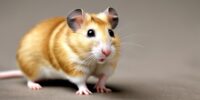What Are the Breeding Behaviors of Hamsters?
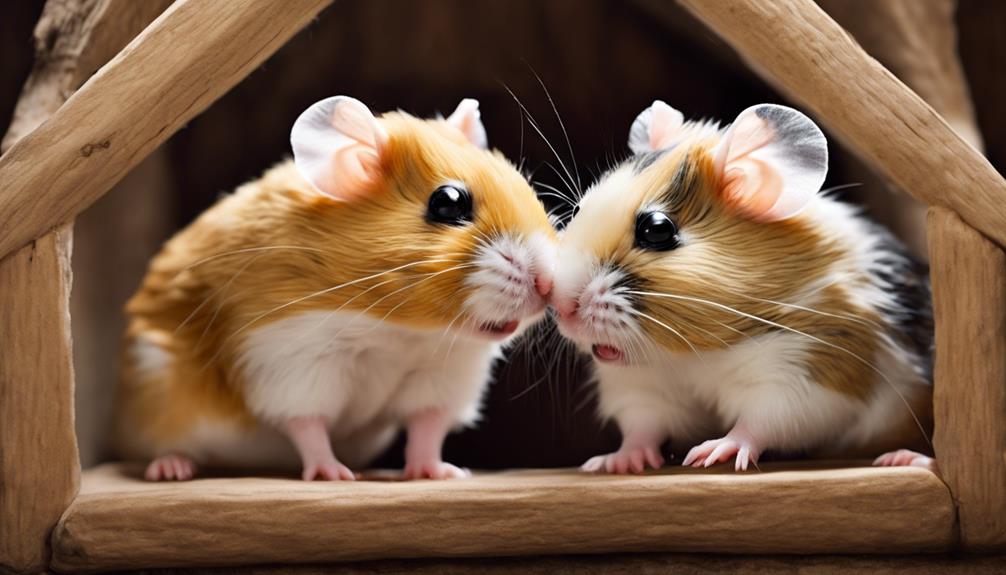
Hamster Breeding Behaviors:
Female hamsters can get pregnant as early as four weeks old, showcasing unique reproductive patterns.
Their breeding behaviors include courtship rituals and strong maternal instincts, shaping their reproductive success and challenges.
Hamster Courtship Behavior
During courtship, hamsters engage in intricate behaviors to communicate their readiness to mate. Grooming rituals play a significant role in this process, as hamsters meticulously groom each other to establish a bond and demonstrate affection. This grooming not only helps in maintaining hygiene but also serves as a form of social interaction that strengthens their connection.
Additionally, scent marking is another crucial behavior observed during courtship. Hamsters have scent glands located on their flanks, which they use to mark their territory and communicate through pheromones. By scent marking, hamsters leave behind olfactory signals that convey information about their identity and reproductive status to potential mates.
Understanding these courtship behaviors is essential for hamster breeders as it allows them to create suitable environments that encourage natural mating behaviors. By providing ample opportunities for grooming and scent marking, breeders can help facilitate successful courtship interactions between hamsters, ultimately leading to successful breeding outcomes.
Nesting Instincts in Hamsters
What drives hamsters to exhibit their remarkable nesting instincts? Hamsters, known for their meticulous nature, showcase fascinating nesting habits that provide insight into their innate behaviors. These small creatures go beyond mere shelter, displaying intricate patterns of burrow construction to create cozy homes for themselves and their offspring.
- Nesting Habits: Hamsters exhibit a strong drive to create secure and comfortable nesting spaces, often using their surroundings to build elaborate burrows underground.
- Burrow Construction: Their burrows are carefully designed with multiple tunnels and chambers, serving various purposes such as nesting, storage, and protection.
- Nesting Material Preferences: Hamsters show distinct preferences for specific materials like hay, paper, and soft fabrics, which they use to line their nests and ensure warmth and comfort.
- Nesting Behavior Patterns: These creatures engage in repetitive behaviors like gathering materials, arranging them strategically, and constantly refining their nests, showcasing their dedication to creating a safe and nurturing environment.
Understanding hamsters' nesting instincts provides a glimpse into their natural tendencies and highlights the importance of providing suitable nesting materials to promote their well-being.
Signs of Hamster Mating
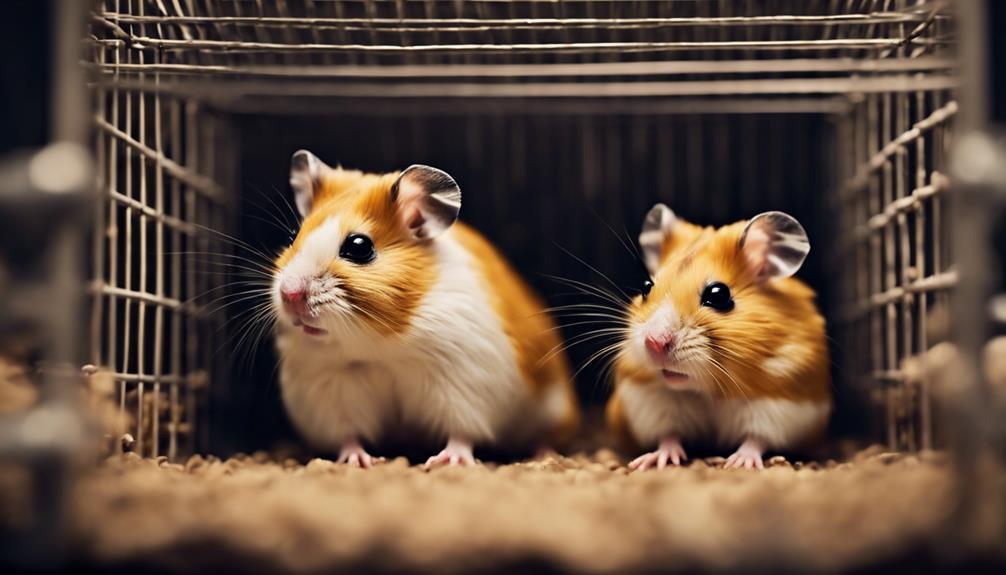
When observing signs of hamster mating, it's crucial to pay attention to the mating behaviors they display. This includes the physical signs that indicate successful mating. Additionally, observing their nesting and burrowing habits can provide valuable insights into the mating process of hamsters, shedding light on their reproductive behaviors and needs.
Mating Behaviors Observed
How do hamsters exhibit signs of mating behavior?
Hamsters display various behaviors indicating their readiness to mate. These behaviors can be observed through hormonal changes and mating success. Here are some key signs to look for:
- Increased Activity: Hamsters may become more active and restless when they're ready to mate.
- Scent Marking: They use scent glands to mark their territory or attract a mate.
- Vocalizations: Hamsters may vocalize more frequently, especially during the mating process.
- Aggressive Behavior: Males may exhibit aggression towards other males when competing for a mate.
These behaviors provide valuable insights into the mating rituals of hamsters, offering a glimpse into their natural instincts and behaviors.
Physical Signs of Mating
Physical cues play a crucial role in signaling the onset of mating behavior in hamsters. When a hamster is in breeding readiness, certain physical cues become evident.
Mating rituals often start with the male hamster approaching the female, displaying courtship behaviors like scent marking and vocalizations. The female, if receptive, may arch her back and raise her hindquarters to signal her readiness to mate.
Physical cues such as chasing, mounting, and increased activity levels are common during this stage. These behaviors are essential in hamster mating, helping to establish compatibility between potential partners.
Understanding these physical signs is vital for hamster breeders to ensure successful mating and the health of the hamsters involved.
Nesting and Burrowing
Nesting and burrowing behaviors in hamsters are instinctual actions that serve as clear signs of mating readiness. Hamsters exhibit these behaviors to prepare for breeding and create a safe space for their young. Here are some key points to consider:
- Bedding Preferences: Hamsters meticulously choose bedding materials like shredded paper or hay to build their nests, ensuring a comfortable environment for their offspring.
- Sleeping Habits: Expectant mothers will spend more time in their nests, resting and preparing for the arrival of their pups.
- Tunneling Behavior: Hamsters may dig tunnels in their enclosures as part of their natural nesting instincts, creating a network of passageways for protection.
- Food Hoarding: Before giving birth, female hamsters may start hoarding food in their nests, ensuring they've easy access to nourishment while caring for their young.
Pregnancy and Gestation Period
During pregnancy, female hamsters undergo a period of gestation lasting around 16 days before giving birth to their litter. Prenatal care for pregnant hamsters involves providing a comfortable and quiet environment, ensuring a balanced diet rich in nutrients, and minimizing disturbances to reduce stress.
As the gestation period progresses, it's essential to monitor the hamster for any signs of complications and be prepared to assist during the birthing process if necessary. Hamster pregnancy is a relatively short but crucial time where the mother's health and well-being greatly impact the litter's outcome.
After giving birth, newborn care is vital to ensure the health and survival of the pups. The mother hamster will instinctively care for her babies by keeping them warm, nursing them, and grooming them. It's essential to provide a secure nesting area and a diet that supports the mother's increased nutritional needs during this time. By following these guidelines, hamster owners can help ensure a successful pregnancy and the healthy development of the newborn hamsters.
Maternal Care in Hamsters
Maternal instincts in hamsters play a crucial role in ensuring the well-being and development of their offspring from birth onwards. Hamsters exhibit remarkable maternal bonding and nurturing instincts, which are essential for the survival of their young.
Here are some key aspects of maternal care in hamsters:
- Maternal Bonding: Hamster mothers form strong bonds with their pups, providing them with a sense of security and comfort during the early stages of life.
- Nurturing Instincts: Female hamsters display remarkable nurturing behaviors, such as grooming, cuddling, and protecting their offspring from potential threats.
- Nursing Behavior: The mother hamster provides essential nourishment to her pups through nursing, ensuring they receive the vital nutrients needed for growth and development.
- Weaning Process: As the pups grow older, the mother initiates the weaning process, gradually introducing solid food and teaching them essential survival skills.
Through their attentive maternal care, hamster mothers play a vital role in preparing their young for independence and survival in the wild.
Understanding Hamster Litters
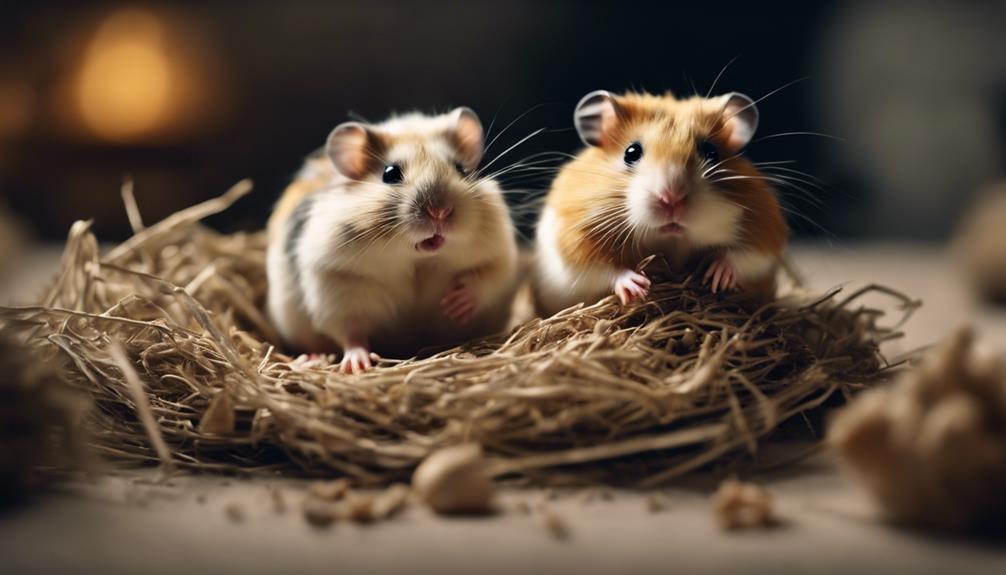
Understanding the dynamics of hamster litters provides valuable insights into the reproductive behaviors of these fascinating small mammals. Hamster litters can vary in size due to genetic factors, with some species typically having larger litters than others. Litter size variations can also be influenced by the age and health of the mother hamster.
During the weaning process, which usually occurs around 3-4 weeks of age, young hamsters start to become more independent from their mother. This period is crucial for their development as they learn to eat solid food and interact with their siblings, helping them develop important social skills.
Social interactions within the litter play a significant role in shaping the behavior of young hamsters. They learn important lessons about hierarchy, boundaries, and communication through play and gentle wrestling with their littermates. These interactions are vital for their social development and overall well-being.
Understanding these aspects of hamster litters can offer valuable insights into the complex world of hamster breeding and social dynamics.
Postpartum Behaviors of Hamsters
Observing the postpartum behaviors of hamsters provides valuable insights into their care and nurturing instincts. During this period, hamsters exhibit a range of behaviors that are essential for the well-being of their offspring.
- Postpartum bonding: Hamster mothers form strong bonds with their pups, providing warmth and protection. They're attentive to their young, nursing them and keeping them close for comfort and security.
- Weaning process: As the pups grow, the mother gradually introduces solid food to them, teaching them essential skills for independent survival.
- Maternal aggression: While hamster mothers are typically gentle, they can display aggression if they feel their pups are threatened. This protective instinct ensures the safety of the litter.
- Postpartum depression: In some cases, hamster mothers may experience postpartum depression, showing signs of lethargy or neglect towards their pups. Understanding and addressing this condition is crucial for the well-being of both the mother and her litter.
Breeding Challenges and Solutions
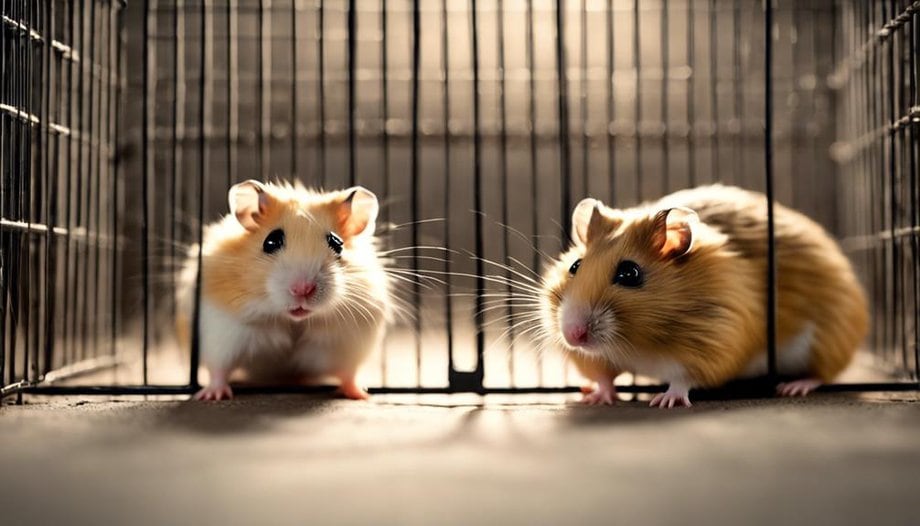
Challenges in breeding hamsters often arise due to factors such as genetic predispositions and environmental stressors, requiring thoughtful solutions to ensure successful reproduction. When faced with reproductive issues, hamster breeders need to implement effective breeding solutions to overcome these obstacles and increase breeding success.
| Breeding Challenges | Breeding Solutions |
|---|---|
| Genetic predispositions | Selective breeding |
| Environmental stressors | Providing a calm and safe environment |
| Infertility issues | Consulting a veterinarian |
| Aggressive behavior | Separating incompatible pairs |
| Postpartum complications | Monitoring and providing postnatal care |
Understanding these breeding challenges and implementing the appropriate breeding solutions can significantly improve the chances of successful hamster reproduction. By addressing these issues proactively, breeders can create a conducive environment for their hamsters to thrive and reproduce successfully, ensuring the well-being of both the parents and their offspring.
Frequently Asked Questions
Can Hamsters Breed With Other Rodent Species?
Hamsters typically do not breed with other rodent species due to reproductive isolation. Interspecies mating rarely occurs and may not result in viable hybrid offspring. Genetics play a crucial role in determining compatibility and successful reproduction among different rodent species.
How Long Should You Wait Before Breeding a Female Hamster Again After She Has Given Birth?
After giving birth, a female hamster should wait at least 4-6 weeks before breeding again. Breeding too frequently can lead to health issues for the mother and offspring. It's crucial to consider their well-being.
Do Hamsters Exhibit Any Territorial Behaviors During the Breeding Process?
During the breeding process, hamsters may exhibit territorial behaviors such as marking their territory with scent glands. They can also display aggression levels towards other hamsters to establish dominance. Nesting habits and social interactions play a role in their mating rituals.
What Are Some Common Health Issues That Can Arise During Hamster Pregnancies?
During hamster pregnancies, it's crucial to monitor weight and watch for pregnancy complications. The gestation period is around 15-20 days. Health risks can include dystocia, a condition where the female struggles to deliver offspring, needing immediate attention.
Are There Any Specific Dietary Requirements for Pregnant or Nursing Hamsters?
During pregnancy and nursing, hamsters have specific nutritional needs. They require a diet rich in protein, calcium, and vitamins. Supplements may be necessary. Understanding the gestation period and weaning process is crucial for supporting the health of the mother and babies.

